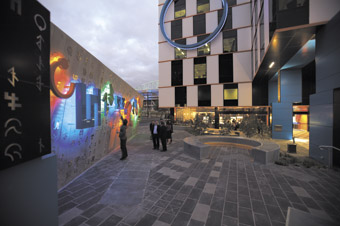the digitising of public art
christian mccrae walks into troy innocent’s field of play

Field of Play, Digital Harbour
THE DOCKLAND DIGITAL HARBOUR AREA IS A DOUBLY VIRTUAL REALITY. COMPRISING THREE MAIN BUILDINGS (PORT 1010, INNOVATION, LIFE.LAB), BUT STILL TAKING SHAPE, EACH is MEANT TO EMBODY THE POSSIBILITIES OF AN INTERCONNECTED TECHNOLOGY AND RESEARCH CENTRE WHOSE PARAMETERS AND STYLE ARE YET TO BE REALISED. THE DOCKLANDS THEMSELVES ARE A VIRTUAL REALITY, MELBURNIANS STILL ATTEMPTING TO CONNECT A NEW URBAN SPACE WITH THE PRE-EXISTING CONCEPTUAL MAP OF A CITY GROWING LIKE IVY—IF IN A WEB OF STRAIGHT LINES. IN EVERY SENSE, THE ARCHITECTURE AND STREETSCAPES OF THE DOCKLANDS AREA ARE CONTESTED, VIRTUAL, UNREAL.
It is in this uncertain, unstable zone that Troy Innocent’s new work, Field of Play, toys with the abstractions of place and shape that form all of our sensations of location. In the shadow of these buildings, Innocent’s signs and colours of indeterminate origin coalesce and dance. Sets of paving stones are lit from beneath with colours and shapes, while a nearby wall acts as a neon Rosetta Stone, runes and letters from alien languages glowing in the dark. It takes only a moment to realise that a game is on offer.
Twin versions of the game, loosely collected around the concepts of ‘here’ and ‘there’, allow players to participate through the related website—or a powerful phone—controlling the lighted paving stones between the three buildings. The game uses the rules of Janken (rock-paper-scissors) to let players score points on a playing field of several either/or segments. Three players choose colours and hedge bets against the odds of being superseded by the colour above them in the cycle: green beats blue, blue beats orange, orange beats green. The game is playable on two planes of virtuality: online through the work’s website and secondly through the lights and paver stones of Digital Harbour, if you’re connected by a sufficiently powerful mobile phone. The second iteration adds an element of naturalism to the play, like digital divining rods bending with the promise of water as the lights below shift and rearrange in response to the twitches of your thumb.
Innocent’s conceptualisation of the game’s materiality is perhaps the most striking element. What seems to be Digital Harbour’s curious relationship to its own history as a docking port is suddenly illuminated as a zone of translation, transition and transaction. The three coloured lingua (orange, blue, green) of Field of Play are tied in Innocent’s formulation to electronic networks, digital games and tribal cultures respectively—avatar forms of the three surroundingbuildings. His previous works have also borne out this fascination with the properties of digital language, coalescing figures around the molecular drifts and eddys of the ether which we have become so accustomed to navigating.
Yet Field of Play takes on properties of this incorporeal dialogic previously undetected and uncelebrated with a ritualised and sacral tone. What was clearly envisaged as an enlivening of an open space instead broaches the implicit coda like a taboo. We are invited to embrace and then to play with the very artificiality of Digital Harbour. For a work so devout in its hermetic appreciation of the digital, players find their appreciation most satisfied by the soft warmth of the speakers and the heat of the luminescent pavers; concrete and glass also being kinds of virtual, remodulated earth. The sensory quality of the art, primary colours and heavy stone at your disposal through microgestures of the thumb and finger, enhances this ritual world.
Everything about Field of Play suggests a design that works during daylight but is more closely incorporated into the night lighting systems of the area. After several visits, the sensation of play transforms, especially during the traditional harbour activity hours of dusk and dawn, as the slate grey of the building is negated when bathed in colour.
Innocent’s digital explorations reveal a fascination with interfaces natural and technological, with the game as a carnival space confusing the two. Here, our playing is not a by-product of labour, or something we earn, deserve or waste. Instead, play is the inhabitation of an experience with a meaning beyond the messy materiality of the game’s duration. The ritual of the game lets even concrete pavers have a life of their own.
Melbourne Docklands Urban Art Program; Troy Innocent, Field of Play (2007), painted aluminium, custom luminaires, lasercut steel, shotblast pavers, multi-player digital game, computer-controlled light, four-channel sound; Harbour Lane, Digital Harbour, Melbourne Docklands, http://fieldofplay.net/
RealTime issue #79 June-July 2007 pg. 24






